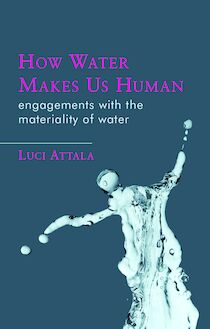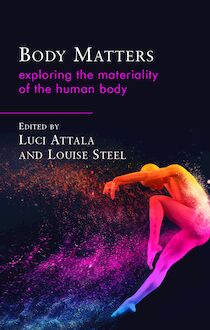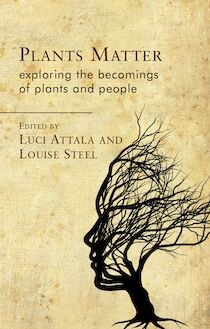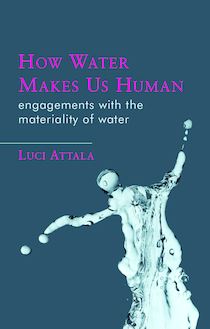Body Matters , livre ebook
124
pages
English
Ebooks
2019
Vous pourrez modifier la taille du texte de cet ouvrage
Obtenez un accès à la bibliothèque pour le consulter en ligne En savoir plus
Découvre YouScribe en t'inscrivant gratuitement
Découvre YouScribe en t'inscrivant gratuitement
124
pages
English
Ebooks
2019
Vous pourrez modifier la taille du texte de cet ouvrage
Obtenez un accès à la bibliothèque pour le consulter en ligne En savoir plus
Publié par
Date de parution
01 mai 2019
Nombre de lectures
1
EAN13
9781786834171
Langue
English
Publié par
Date de parution
01 mai 2019
Nombre de lectures
1
EAN13
9781786834171
Langue
English
MATERIALITIES IN ANTHROPOLOGY AND ARCHAEOLOGY
BODY MATTERS
MATERIALITIES IN ANTHROPOLOGY AND ARCHAEOLOGY
SERIES EDITORS
Luci Attala and Louise Steel
University of Wales Trinity Saint David
SERIES EDITORIAL BOARD
Dr Nicole Boivin
Director of the Max Planck Institute for the Science of Human History
Professor Samantha Hurn
University of Exeter
Dr Oliver Harris
University of Leicester
Professor David Howes
Concordia Centre for Interdisciplinary Studies in Society and Culture
Dr Elizabeth Rahman
University of Oxford
MATERIALITIES IN ANTHROPOLOGY AND ARCHAEOLOGY
BODY MATTERS
EXPLORING THE MATERIALITY OF THE HUMAN BODY
Edited by
LUCI ATTALA and LOUISE STEEL
© The Contributors, 2019
All rights reserved. No part of this book may be reproduced in any material form (including photocopying or storing it in any medium by electronic means and whether or not transiently or incidentally to some other use of this publication) without the written permission of the copyright owner except in accordance with the provisions of the Copyright, Designs and Patents Act 1988. Applications for the copyright owner’s written permission to reproduce any part of this publication should be addressed to the University of Wales Press, University Registry, King Edward VII Avenue, Cardiff CF10 3NS.
www.uwp.co.uk
British Library Cataloguing-in-Publication Data
A catalogue record for this book is available from the British Library.
ISBN 978-1-78683-415-7
eISBN 978-1-78683-417-1
The right of Luci Attala and Louise Steel to be identified as editors of this work has been asserted in accordance with sections 77 and 79 of the Copyright, Designs and Patents Act 1988.
The publisher has no responsibility for the persistence or accuracy of URLs for any external or third-party internet websites referred to in this book, and does not guarantee that any content on such websites is, or will remain, accurate or appropriate.
Cover design: Hayes Design
In memory of Mark Pluciennik
CONTENTS
List of figures
Acknowledgements
List of contributors
Preface
1 Introduction
Luci Attala and Louise Steel
2 Bodies that co-create: The residues and intimacies of vital materials
Eloise Govier
3 ‘I am apple’: Relationships of the flesh. Exploring the corporeal entanglements of eating plants in the Amazon
Luci Attala
4 Cooled, cured and sedimented: Reforming and edifying the hydrocentric infants of northwestern Amazonia
Elizabeth Rahmen
5 Embodied encounters with the ancestors
Louise Steel
6 Becoming a community of substance: The Mun, the mud and the therapeutic art of body painting
Kate Nialla Fayers-Kerr
7 The resuscitation of the twice-hanged man: Miracles and the body in medieval Swansea
Harriett Webster
8 Dead and dusted: Exploring the mutable boundaries of the body
Ros Coard
9 A cup for any occasion? The materiality of drinking experiences at Kerma
Carl Walsh
10 All fingers, no thumbs: The materiality of a medieval relic
Janet Burton
References
Notes
Glossary
LIST OF FIGURES
Fig. 2.1 ‘Dirt Drawings’ by artist Suze Adams produced during her performed artist residency ‘At One Remove’ for the Cartesian Cut? Exhibition 2016 . Photo: Eloise Govier.
Fig. 4.1 Splash-washing in the river, beside the petrified ancestor rock. Photo: Elizabeth Rahmen.
Fig. 4.2 The image depicts one of two locales named as ‘the infant’s waterfall’. According to the narration, culture-hero Napiruli, arrived at this spot to find a woman bathing her baby, and he named it as such. Photo: Elizabeth Rahmen.
Fig. 5.1 Plastered skull from Jericho © UCL Institute of Archaeology.
Fig. 5.2 Making a plastered skull. Photo: Louise Steel.
Fig. 5.3 Disarticulated bones from Arediou Tomb 1. Photo: Steve Thomas.
Fig. 6.1 After a parent has playfully smeared a toddler with 115 dung, Bulu, October 2010. Photo: Kate Fayers-Kerr.
Fig. 6.2 An older boy being painted with yellow clay while out with the cattle, Chollo, September 2010. Photo: Kate Fayers-Kerr.
Fig. 6.3 Children and other participants ‘washed’ with white clay on the final day of the bio lama, Ulumholi, July 2010. Photo: Kate Fayers-Kerr.
Fig. 9.1 BTRPW drinking vessels: (a) Beaker EA554423; (b) Beaker EA55415; (c) rilled beaker EA65579. Photo: Carl Walsh, taken courtesy of the Trustees of the British Museum.
Fig. 9.2 BTRPW spouted vessel often referred as a ‘teapot’ EA65577. Photo: Carl Walsh, taken courtesy of the Trustees of the British Museum.
Fig. 9.3 Author showcasing the two-handed holding 186 technique with beaker EA554423. Photo: Carl Walsh, taken courtesy of the Trustees of the British Museum.
Fig. 10.1 Arm reliquary of St Elisabeth, c. 1240, from 203 the former Premonstratensian monastery of Altenberg © Bildarchiv Foto Marburg.
ACKNOWLEDGEMENTS
W e would like to acknowledge the many people who have helped us bring this volume together. First and foremost, we would like to thank our contributors for their lively and stimulating chapters, which variously address the human body as matter. We are grateful for their enthusiasm and engagement with the ideas informing the theoretical backbone of this volume. Luci would like to recognize her children’s part in getting this book to press; you all are an absolute delight, and every distraction is now forgiven. Thank you also to Steve Thomas; as always, a constant source of good humour who also provided an objective view on our writing. We would also like to recognize the role our wonderful students have played in shaping this volume. This book would not be the same without your fabulously challenging questions, conclusions, associations and suggestions.
Particular thanks are due to Tim Ihssen, who greatly aided us in the final stages of bringing the manuscript together, cheerfully undertaking a meticulous copy-edit and also for help in drawing up the index, and to Janet Burton, whose words of wisdom kept us sane throughout. Sarah Lewis commissioned the Materialities in Anthropology and Archaeology series for the University of Wales Press – we greatly appreciate her enthusiasm and help in establishing this series and for her patience and guidance through the editing process.
A number of seemingly disparate threads tangled together to form this volume: Louise’s work with clay and lime plaster, Luci’s work with water and plastics, and working with our students in the Materialities Lab, all of which encouraged deeper, sharper thinking about how people can and do engage with materials. We were not so much concerned with how things get made, but rather posed the question: how do people work with materials? And, of course, the answer came back – they work ‘materially’. Clearly, people do not work with materials by thinking alone, they work with them physically through and as bodies. It was this realization that acted as the initial impetus for this volume: to explore the body as a material in relationship with a wider, expanding and shifting landscape of materials together.
Some of the inspiration for this book can also be attributed to our former colleague Mark Pluciennik and the vibrant discussions in the Thinking through the Body workshop held at the University of Wales, Lampeter, in June 1998. We affectionately dedicate this book to his memory.
LIST OF CONTRIBUTORS
Luci Attala is Senior Lecturer in Anthropology at the University of Wales Trinity Saint David. Her research focuses on materialities, with specific attention to coalescing themes of incorporation, ingestion and the becomings of ecological interacting bodies. Luci is currently exploring engagements with water in rural Kenya, Spain and Wales by asking the question ‘How does water make us human?’ She maps the flows of water through various bodies and looks at plant–human interactions within the body and wider environmental settings. In 2014, Luci’s work in Kenya was recognized by the United Nations with the receipt of a Gold Star Award; the following year, she received the Green Gown Award as Sustainability Champion in Higher Education. Together with Louise Steel, Luci is the Materialities in Anthropology and Archaeology series editor for the University of Wales Press.
Janet Burton is Professor of Medieval History at the University of Wales Trinity Saint David. She has published widely in the area of medieval monastic history, including (with Julie Kerr), The Cistercians in the Middle Ages (Woodbridge: Boydell, 2011, 2016), and Historia Selebiensis Monasterii: the History of the Monastery of Selby (Oxford Medieval Texts: OUP, 2013). She is a co-director of the Monastic Wales Project ( www.monasticwales.org ) and co-author and co-editor of Monastic Wales: New Approaches (Cardiff; University of Wales Press, 2013) and Abbeys and Priories of Medieval Wales (Cardiff: University of Wales Press, 2015). With Karen Stöber, she is a general editor of The Journal of Medieval Monastic Studies and the associated book series Medieval Monastic Studies , both published by Brepols. She is a former vice-president of the Royal Historical Society and a Fellow of the Learned Society of Wales.
Ros Coard is Senior Lecturer in Archaeology at the University of Wales Trinity Saint David. Having trained at Sheffield University in Archaeology and Prehistory, her research focuses on the study of Plio-Pleistocene fossil assemblages, faunal analysis and vertebrate taphonomy. More recently, her skills gained in the field when studying fossil assemblages have translated to the world of forensic studies. Her long-standing interest is to understand what agents of destruction and preservation have enabled human or animal bone assemblages to survive, or not, in a particular environment, and to understand what happens to once living creatures as they die and become part of the fossil record. The transition from the body live to the skeleton dead never ceases to fascinate.
Kate Fayers-Kerr is research associate at the Institute of Social and Cultural Anthropology





